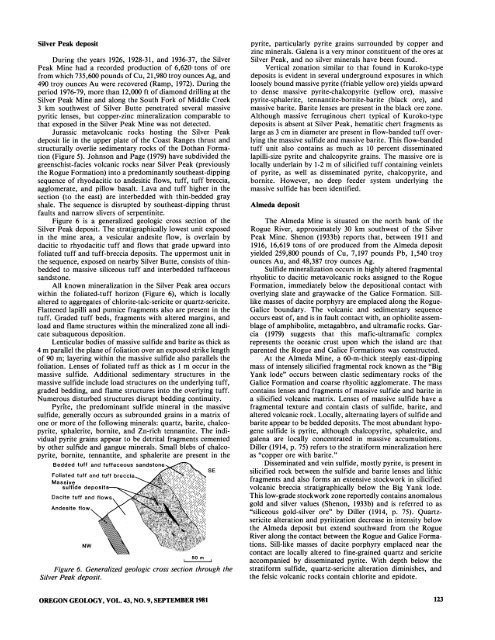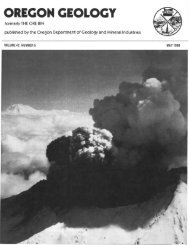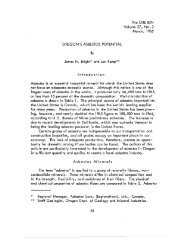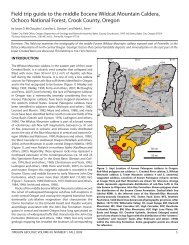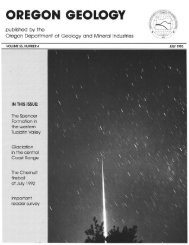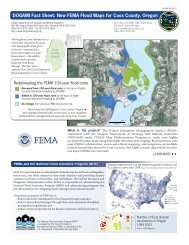Ore Bin / Oregon Geology magazine / journal - Oregon Department ...
Ore Bin / Oregon Geology magazine / journal - Oregon Department ...
Ore Bin / Oregon Geology magazine / journal - Oregon Department ...
Create successful ePaper yourself
Turn your PDF publications into a flip-book with our unique Google optimized e-Paper software.
Silver Peak deposit<br />
During the years 1926, 1928-31, and 1936-37, the Silver<br />
Peak Mine had a recorded production of 6,620· tons of ore<br />
from which 735,600 pounds of Cu, 21,980 troy ounces Ag, and<br />
490 troy ounces Au were recovered (Ramp, 1972). During the<br />
period 1976-79, more than 12,000 ft of diamond drilling at the<br />
Silver Peak Mine and along the South Fork of Middle Creek<br />
3 km southwest of Silver Butte penetrated several massive<br />
pyritic lenses, but copper-zinc mineralization comparable to<br />
that exposed in the Silver Peak Mine was not detected.<br />
Jurassic metavolcanic rocks hosting the Silver Peak<br />
deposit lie in the upper plate of the Coast Ranges thrust and<br />
structurally overlie sedimentary rocks of the Dothan Formation<br />
(Figure 5). Johnson and Page (1979) have subdivided the<br />
greenschist-facies volcanic rocks near Silver Peak (previously<br />
the Rogue Formation) into a predominantly southeast-dipping<br />
sequence of rhyodacitic to andesitic flows, tuff, tuff breccia,<br />
agglomerate, and pillow basalt. Lava and tuff higher in the<br />
section (to the east) are interbedded with thin-bedded gray<br />
shale. The sequence is disrupted by southeast-dipping thrust<br />
faults and narrow slivers of serpentinite.<br />
Figure 6 is a generalized geologic cross section of the<br />
Silver Peak deposit. The stratigraphically lowest unit exposed<br />
in the mine area, a vesicular andesite flow, is overlain by<br />
dacitic to rhyodacitic tuff and flows that grade upward into<br />
foliated tuff and tuff-breccia deposits. The uppermost unit in<br />
the sequence, exposed on nearby Silver Butte, consists of thinbedded<br />
to massive siliceous tuff and interbedded tuffaceous<br />
sandstone.<br />
All known mineralization in the Silver Peak area occurs<br />
within the foliated-tuff horizon (Figure 6), which is locally<br />
altered to aggregates of chlorite-talc-sericite or quartz-sericite.<br />
Flattened lapilli and pumice fragments also are present in the<br />
tuff. Graded tuff beds, fragments with altered margins, and<br />
load and flame structures within the mineralized zone all indicate<br />
subaqueous deposition.<br />
Lenticular bodies of massive sulfide and barite as thick as<br />
4 m parallel the plane of foliation over an exposed strike length<br />
of 90 m; layering within the massive sulfide also parallels the<br />
foliation. Lenses of foliated tuff as thick as 1 m occur in the<br />
massive sulfide. Additional sedimentary structures in the<br />
massive sulfide include load structures on the underlying tuff,<br />
graded bedding, and flame structures into the overlying tuff.<br />
Numerous disturbed structures disrupt bedding continuity.<br />
Pyrite, the predominant sulfide mineral in the massive<br />
sulfide, generally occurs as subrounded grains in a matrix of<br />
one or more of the following minerals: quartz, barite, chalcopyrite,<br />
sphalerite, bornite, and Zn-rich tennantite. The individual<br />
pyrite grains appear to be detrital fragments cemented<br />
by other sulfide and gangue minerals. Small blebs of chalcopyrite,<br />
bornite, tennantite, and sphalerite are present in the<br />
Bedded tuff and tuffaceous sand<br />
Dacite tuff and<br />
Andesite flow<br />
NW<br />
I 50 m !<br />
Figure 6. Generalized geologic cross section through the<br />
Silver Peak deposit.<br />
SE<br />
pyrite, particularly pyrite grains surrounded by copper and<br />
zinc minerals. Galena is a very minor constituent of the ores at<br />
Silver Peak, and no silver minerals have been found.<br />
Vertical zonation similar to that found in Kuroko-type<br />
deposits is evident in several underground exposures in which<br />
loosely bound massive pyrite (friable yellow ore) yields upward<br />
to dense massive pyrite-chalcopyrite (yellow ore), massive<br />
pyrite-sphalerite, tennantite-bornite-barite (black ore), and<br />
massive barite. Barite lenses are present in the black ore zone.<br />
Although massive ferruginous chert typical of Kuroko-type<br />
deposits is absent at Silver Peak, hematitic chert fragments as<br />
large as 3 cm in diameter are present in flow-banded tuff overlying<br />
the massive sulfide and massive barite. This flow-banded<br />
tuff unit also contains as much as 10 percent disseminated<br />
lapilli-size pyrite and chalcopyrite grains. The massive ore is<br />
locally underlain by 1-2 m of silicified tuff containing vein lets<br />
of pyrite, as well as disseminated pyrite, chalcopyrite, and<br />
bornite. However, no deep feeder system underlying the<br />
massive sulfide has been identified.<br />
Almeda deposit<br />
The Almeda Mine is situated on the north bank of the<br />
Rogue River, approximately 30 km southwest of the Silver<br />
Peak Mine. Shenon (1933b) reports that, between 1911 and<br />
1916, 16,619 tons of ore produced from the Almeda deposit<br />
yielded 259,800 pounds of Cu, 7,197 pounds Pb, 1,540 troy<br />
ounces Au, and 48,387 troy ounces Ag.<br />
Sulfide mineralization occurs in highly altered fragmental<br />
rhyolitic to dacitic metavolcanic rocks assigned to the Rogue<br />
Formation, immediately below the depositional contact with<br />
overlying slate and graywacke of the Galice Formation. Silllike<br />
masses of dacite porphyry are emplaced along the Rogue<br />
Galice boundary. The volcanic and sedimentary sequence<br />
occurs east of, and is in fault contact with, an ophiolite assemblage<br />
of amphibolite, metagabbro, and ultramafic rocks. Garcia<br />
(1979) suggests that this mafic-ultramafic complex<br />
represents the oceanic crust upon which the island arc that<br />
parented the Rogue and Galice Formations was constructed.<br />
At the Almeda Mine, a 60-m-thick steeply east-dipping<br />
mass of intensely silicified fragmental rock known as the "Big<br />
Yank lode" occurs between clastic sedimentary rocks of the<br />
Galice Formation and coarse rhyolitic agglomerate. The mass<br />
contains lenses and fragments of massive sulfide and barite in<br />
a silicified volcanic matrix. Lenses of massive sulfide have a<br />
fragmental texture and contain clasts of sulfide, barite, and<br />
altered volcanic rock. Locally, alternating layers of sulfide and<br />
barite appear to be bedded deposits. The most abundant hypogene<br />
sulfide is pyrite, although chalcopyrite, sphalerite, and<br />
galena are locally concentrated in massive accumulations.<br />
Diller (1914, p. 75) refers to the stratiform mineralization here<br />
as "copper ore with barite."<br />
Disseminated and vein sulfide, mostly pyrite, is present in<br />
silicified rock between the sulfide and barite lenses and lithic<br />
fragments and also forms an extensive stockwork in silicified<br />
volcanic breccia stratigraphically below the Big Yank lode.<br />
This low-grade stockwork zone reportedly contains anomalous<br />
gold and silver values (Shenon, 1933b) and is referred to as<br />
"siliceous gold-silver ore" by Diller (1914, p. 75). Quartzsericite<br />
alteration and pyritization decrease in intensity below<br />
the Almeda deposit but extend southward from the Rogue<br />
River along the contact between the Rogue and Galice Formations.<br />
Sill-like masses of dacite porphyry emplaced near the<br />
contact are locally altered to fine-grained quartz and sericite<br />
accompanied by disseminated pyrite. With depth below the<br />
stratiform sulfide, quartz-sericite alteration diminishes, and<br />
the felsic volcanic rocks contain chlorite and epidote.<br />
OREGON GEOLOGY, VOL. 43, NO.9, SEPTEMBER 1981<br />
123


